Indicated Resource Increases by 3x, Maintains Inferred Resource Size
Toronto, November 1st, 2022 – Canadian Copper Inc. (“Canadian Copper” or the “Company”) (CSE:CCI) is pleased to announce a new Mineral Resource Estimate (“MRE” or “Mineral Resources”) for the Chester Copper Project (“Chester”) located in New Brunswick, Canada. The MRE was prepared by APEX Geoscience Ltd. (“APEX”) in accordance with the Canadian Institute of Mining, Metallurgy and Petroleum (“CIM”) Definition Standards and National Instrument 43-101 – Standards of Disclosure for Mineral Projects (“43-101”).
“Today’s MRE is an excellent milestone in our value enhancing and systematic de-risking initiatives for the Chester Project. Our exploration efforts to date have improved our understanding of the geologic model and resulted in a larger and more robust copper resource. Regional exploration continues at the Chester Project which will help build on this growing copper resource. Presently, 80% of the resources are within 100 meters of surface at +1% Cu grade, and the deposit remains open along strike and at depth.”
—Simon Quick, CEO of Canadian Copper
Mineral Resource Estimate Highlights
- Indicated Mineral Resources: 4.866 million tonnes (“Mt”) at a grade of 1.13% copper, containing 120.28 million pounds (“Mlbs”) of copper, with potential by-product of 13.66 Mlbs lead, 10.52 Mlbs zinc, 69,000 ounces of silver, or potentially 7.51 Mlbs of in situ copper equivalent (“CuEq”)*.
- Inferred Mineral Resources: 1.819 million tonnes (“Mt”) at a grade of 1.01% copper, containing 38.35 million pounds (“Mlbs”) of copper, with potential by-product of 3.17 Mlbs lead, 1.57 Mlbs zinc, or potentially 1.35 Mlbs of copper equivalent (“CuEq”)*.
Next Steps for the Chester Project
- Based on hole C21:07 (click here for more information) which is a 200-meter step-out to any previous drilling, complete block model evaluation to define drill targets that will future test extensions of the MRE both at depth and along strike. Several high-grade copper veinlets up to 3.55% Cu within a copper envelop grading 0.2% Cu over 83.90 meters confirming the extensions to the Stringer Zone at depth.
- A metallurgical characterization test program is underway at RPC Science & Engineering based in Fredericton, New Brunswick which is partially funded through The National Research Council of Canada Industrial Research Assistance Program (“NRC IRAP”). The objectives of this metallurgical program are to improve our beneficiation understanding and investigate recovery opportunities for the Central and the East Zones at Chester.
- Conceptual open pit mine planning to further identify value enhancing opportunities of this outcropping VMS deposit. Specifically, this effort will assist in our next exploration program planning to define drill targets that will further improve economics as-well as upgrade historic drilling that is excluded from this MRE including additional by-product metal domains.
- Investigate Chester mineralization amenability to bulk ore sorting technology as means to improve deposit economics.
Mineral Resource Estimate
This MRE for Chester is based on data with a cut-off date of August 31, 2022. The MRE is reported with an effective date of October 27, 2022.
Table 1: Open Pit Mineral Resource Estimate at a cut-off of 0.5% copper*

*Notes to Table 1:
- The unconstrained resource block model was estimated using ordinary kriging utilizing blocks at 3m(X) x 3m(Y) x3m (Z) and was then subjected to several open pit optimization scenarios utilizing a number of copper prices, mining cost scenarios and recovery factors typical of copper mining operations and advanced projects. The Chester final MRE pit shell utilized a copper price of US$3.50/lb and recoveries of 95% with appropriate mining and processing costs typical of near surface open pittable resources in Eastern Canada. Mr. Dufresne considers the pit parameters presented below are appropriate to evaluate the reasonable prospect for potential future economic extraction at the Chester Project for the purpose of providing an MRE.
- The updated resources presented are not mineral reserves, and they do not have demonstrated economic viability. There is no guarantee that any part of the resources defined by the updated MRE will be converted to a mineral reserve in future.
- The Inferred Mineral Resource in this estimate has a lower level of confidence than that applied to an Indicated Mineral Resource and must not be converted to a Mineral Reserve. It is reasonably expected that the majority of the Inferred Mineral Resource could potentially be upgraded to an Indicated Mineral Resource with continued exploration.
- The Mineral Resources were estimated in accordance with the Canadian Institute of Mining, Metallurgy and Petroleum (CIM), CIM Standards on Mineral Resources and Reserves, Definitions (2014) and Best Practices Guidelines (2019) prepared by the CIM Standing Committee on Reserve Definitions and adopted by the CIM Council.
- Historical mined areas were removed from the block modelled resources.
- The estimate of Mineral Resources may be materially affected by environmental, permitting, legal, title, taxation, socio-political, marketing, or other relevant issues.
- Totals may not add due to rounding.
Figure 1: Base Case Pit Constrained MRE, Plan View
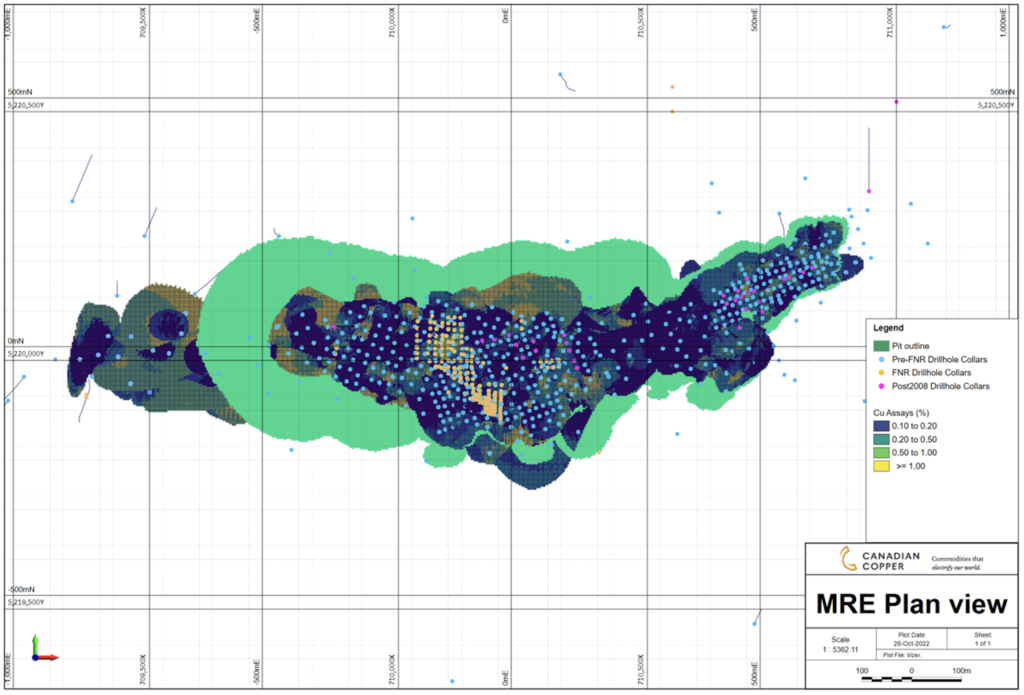
Figure 2: Base Case Pit Constrained MRE, Orthogonal View
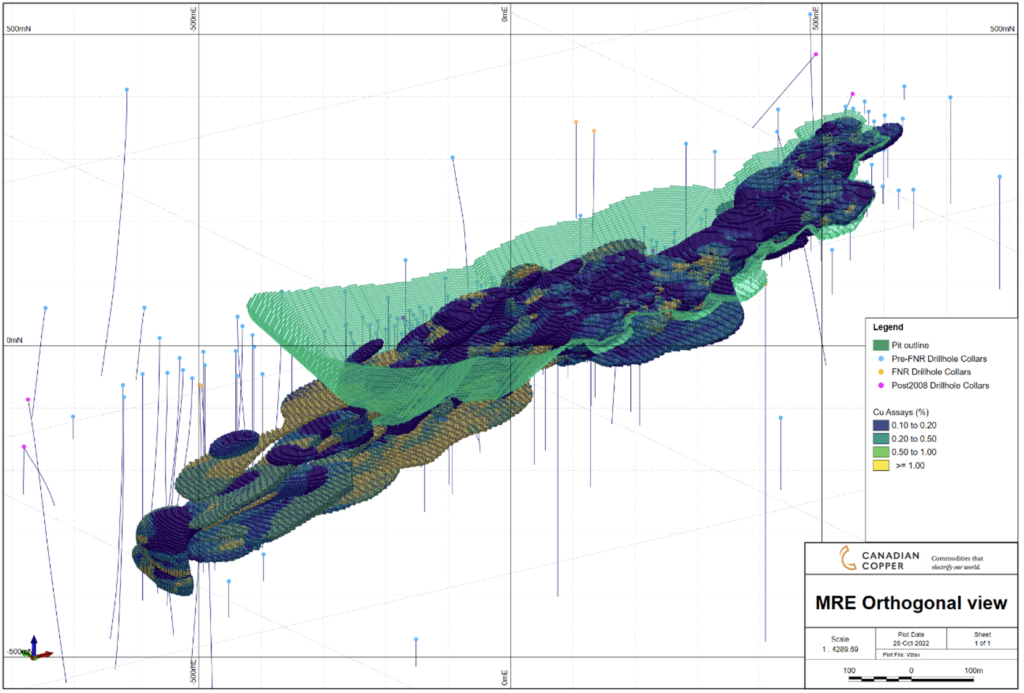
Parameters used to constrain the MRE within an open pit shell
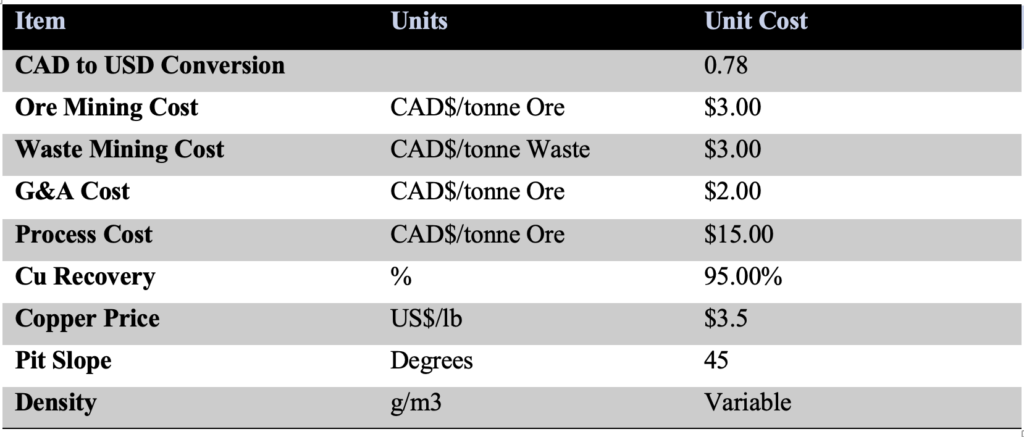
Sensitivity Analysis
A sensitivity analysis is presented below to help conceptualize grade and tonnage estimates at various cut-off grade increments for the Chester deposit. This is not to be interpreted or construed as the base case of the Mineral Resource Estimate discussed above. Table 3 displays current copper MRE at 0.5% cut-off as groups of domains with potential by-product metals.
Figure 3: Long Section and Cross Section Through Chester MRE
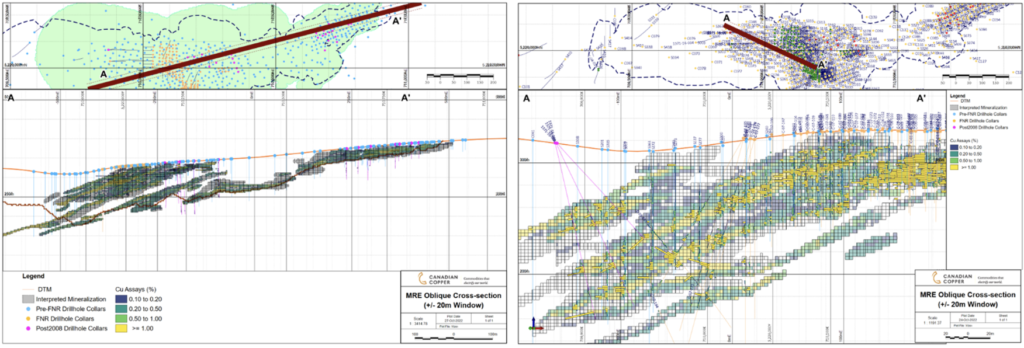
Figure 4: Grade-Tonnage Curve for Chester Mineral Resources
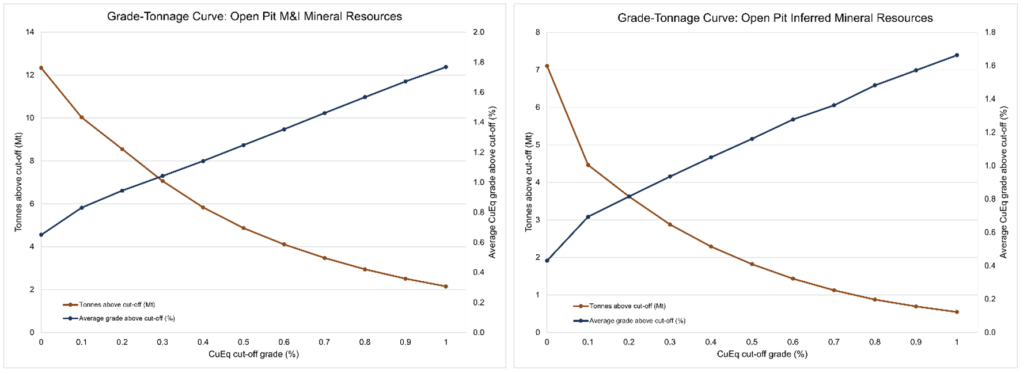
Table 2: Grade-Tonnage Sensitivity Table for Chester Mineral Resources*
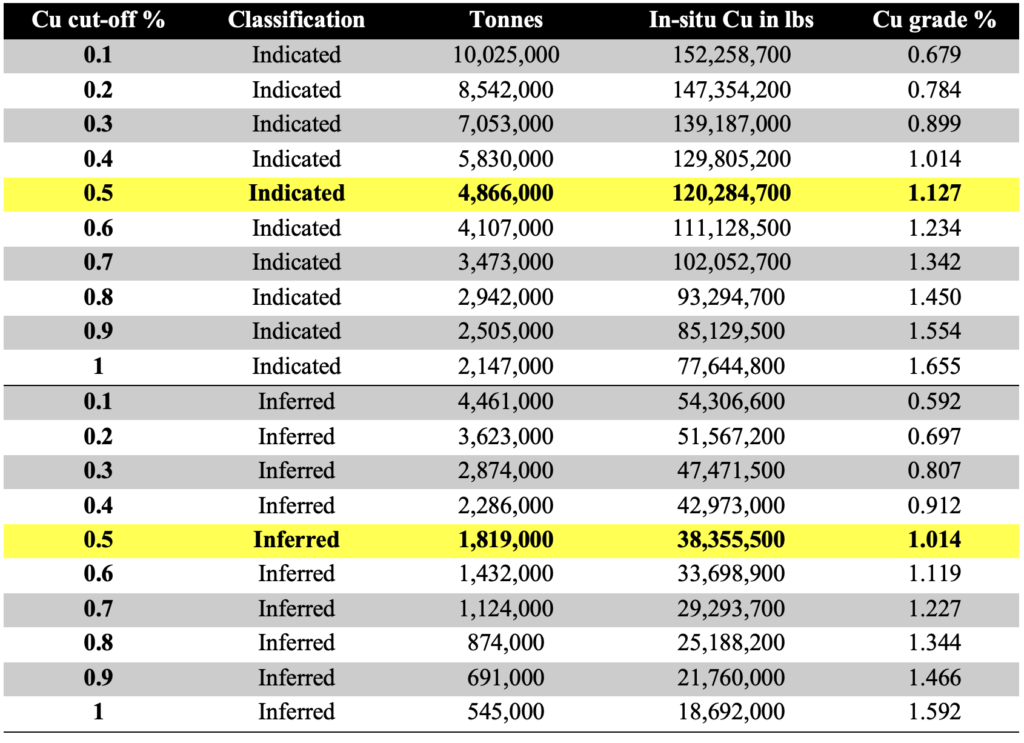
*Notes to Table 2:
- The unconstrained resource block model was estimated using ordinary kriging utilizing blocks at 3m(X) x 3m(Y) x3m (Z) and was then subjected to several open pit optimization scenarios utilizing a number of copper prices, mining cost scenarios and recovery factors typical of copper mining operations and advanced projects. The Chester final MRE pit shell utilized a copper price of US$3.50/lb and recoveries of 95% with appropriate mining and processing costs typical of near surface open pittable resources in Eastern Canada. Mr. Dufresne considers the pit parameters presented below are appropriate to evaluate the reasonable prospect for potential future economic extraction at the Chester Project for the purpose of providing an MRE.
- The updated resources presented are not mineral reserves, and they do not have demonstrated economic viability. There is no guarantee that any part of the resources defined by the updated MRE will be converted to a mineral reserve in future.
- The Inferred Mineral Resource in this estimate has a lower level of confidence than that applied to an Indicated Mineral Resource and must not be converted to a Mineral Reserve. It is reasonably expected that the majority of the Inferred Mineral Resource could potentially be upgraded to an Indicated Mineral Resource with continued exploration.
- The Mineral Resources were estimated in accordance with the Canadian Institute of Mining, Metallurgy and Petroleum (CIM), CIM Standards on Mineral Resources and Reserves, Definitions (2014) and Best Practices Guidelines (2019) prepared by the CIM Standing Committee on Reserve Definitions and adopted by the CIM Council.
- Historical mined areas were removed from the block modelled resources.
- The estimate of Mineral Resources may be materially affected by environmental, permitting, legal, title, taxation, socio-political, marketing, or other relevant issues.
- Totals may not add due to rounding.
Table 3: Chester Mineral Resources and Secondary By-Product Metals by Domain*
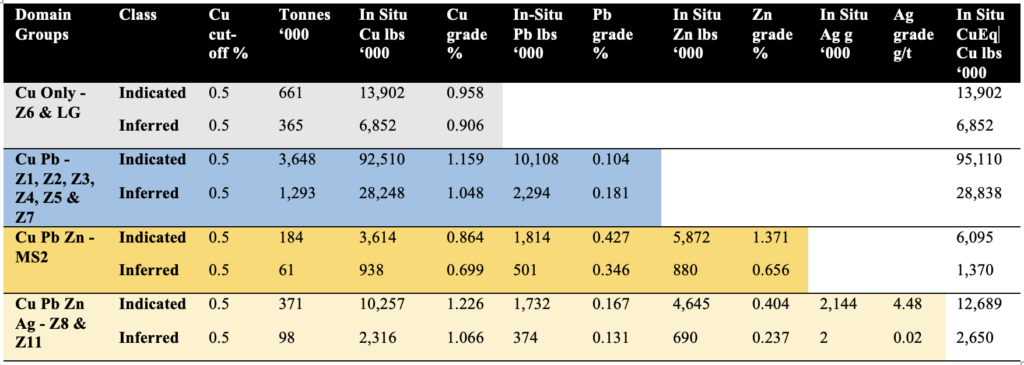
*Notes to Table 3:
- The unconstrained resource block model was estimated using ordinary kriging utilizing blocks at 3m(X) x 3m(Y) x3m (Z) and was then subjected to several open pit optimization scenarios utilizing a number of copper prices, mining cost scenarios and recovery factors typical of copper mining operations and advanced projects. The Chester final MRE pit shell utilized a copper price of US$3.50/lb and recoveries of 95% with appropriate mining and processing costs typical of near surface open pittable resources in Eastern Canada. Mr. Dufresne considers the pit parameters presented below are appropriate to evaluate the reasonable prospect for potential future economic extraction at the Chester Project for the purpose of providing an MRE.
- The updated resources presented are not mineral reserves, and they do not have demonstrated economic viability. There is no guarantee that any part of the resources defined by the updated MRE will be converted to a mineral reserve in future.
- The Inferred Mineral Resource in this estimate has a lower level of confidence than that applied to an Indicated Mineral Resource and must not be converted to a Mineral Reserve. It is reasonably expected that the majority of the Inferred Mineral Resource could potentially be upgraded to an Indicated Mineral Resource with continued exploration.
- The Mineral Resources were estimated in accordance with the Canadian Institute of Mining, Metallurgy and Petroleum (CIM), CIM Standards on Mineral Resources and Reserves, Definitions (2014) and Best Practices Guidelines (2019) prepared by the CIM Standing Committee on Reserve Definitions and adopted by the CIM Council.
- Historical mined areas were removed from the block modelled resources.
- The estimate of Mineral Resources may be materially affected by environmental, permitting, legal, title, taxation, socio-political, marketing, or other relevant issues.
- Ratios used to calculate In Situ Cu equivalent lbs for Pb, Zn and Ag are Pb x 0.257, Zn x 0.342, Ag x 83.333. Prices used are Cu $3.5/lb, Pb $0.9/lb, Zn $1.2/lb, Ag $20/oz.
Geologic Model
The mineralization domains consist of 12 modelled domains that include 10 “stringer” zones, which occur as a network of dendritic veins that often show a very erratic distribution of mineralization, an upper massive sulfide (MS) domain, and a low-grade halo domain surrounding the other domains. The mineralization domain construction utilized an approximate lower cut-off of 0.15% Cu for the interpretation and joining of mineralization shapes. Within the stringer mineralization zones and the MS mineralization zone, a total of 20% of the total drilled meters inside the mineralization wireframes were not sampled, assumed to be waste, and assigned a nominal waste value of half the detection limit of modern assay methods (0.00001% Cu). Within the low-grade halo mineralization domain, a total of 64% of the total drilled meters inside the mineralization wireframe was not sampled, assumed to be waste, and assigned a nominal waste value of half the detection limit of modern assay methods (0.00001% Cu).
Data Verification
The Chester drill hole database, including drill hole surveying, analytical methods, QA/QC protocols and corresponding sample preparation and shipment procedures have been reviewed for historical and current drilling by Mr. Michael Dufresne, M.Sc., P.Geol., P.Geo. and is deemed to be of sufficient quality for resource modelling. The drill hole database contains a total of 712 drill holes with 64,787 meters drilled and 15,330 sample intervals assayed for copper. A total of 43 holes were completed by Canadian Copper and Puma between 2014 and 2021. A total of 191 holes were completed between 2003 and 2007 by First Narrows. A total of 478 historical holes were completed by a number of prior companies between 1963 and 1999. Standard statistical treatments were conducted on the raw and composite samples with a resulting composite length of 1.5 meters for the estimation and a capping limit of 8.7% Cu up to 10.15% Cu, utilized for various domain groups for the Chester Project. Areas and/or domains dominated by pre-2000 drill hole data were estimated but are classified as inferred until such time as modern confirmation drilling is conducted.
Mineral Resource Estimation Methodology
The MRE is based on the combination of geological modeling, geostatistics and conventional block modeling using Ordinary Kriging (OK) and locally varying anisotropy (LVA), capping statistics and variogram models for copper grade interpolation. Block grade estimation employed LVA, which uses different rotation angles to define the principal directions of the variogram model and search ellipsoid on a per-block basis. Modelling was conducted in the Universal Transverse Mercator (UTM) coordinate space relative to the North American Datum (NAD) 1983, Zone 19N (EPSG:26919).
Technical Report
The effective date of the Mineral Resource Estimate is October 27, 2022. A NI 43-101 technical report prepared by APEX Geoscience Ltd will be filed on SEDAR at www.sedar.com within 45 days of this news release and will be available at that time on the Canadian Copper website.
For readers to fully understand the information in this news release they should read the technical report in its entirety when it is available, including all qualifications, assumptions, exclusions and risks. The technical report is intended to be read as a whole and sections should not be read or relied upon out of context.
Qualified Persons
Mr. Michael Dufresne, M.Sc., P.Geol., P.Geo. is President and a Principal of APEX Geoscience Ltd. and is an independent QP. Mr. Dufresne is responsible for the Chester MRE and has reviewed and approved the geological information reported in this news release.
Dominique Gagné, PGeo., is a qualified person as defined by Canadian National Instrument 43-101 standards who is working for Geominex Inc., an independent contractor of the Company. Mr. Gagne has reviewed and approved the geological information reported in this news release.
About the Chester Copper Project
The Chester copper deposit (“Chester”) is a volcanogenic massive sulphide (“VMS”) resource containing three zones; the Central Zone (massive sulphide), the East Zone (massive sulphide), and the West Zone (Copper Stringer), which are all located near surface. Previous mining development in 1974 included a 470-meter decline targeting the West Zone and produced 30,000 tonnes of bulk sample material grading +2.0% Cu (Geoscience Canada, McCutcheon, 2020). No other development has occurred on the property.
About the Bathurst Mining Camp
The Company is focused on the prolific Bathurst Mining Camp of New Brunswick, Canada. This region is a world class mining district with thirteen former mining operations and hosts more than forty-five known volcanogenic massive sulphide (“VMS”) deposits. Our flagship Chester Project is 75 km south of the renowned Brunswick #12 mine that operated for 5 decades. New Brunswick has the modern infrastructure needed for mineral exploration and mine development coupled with a clear and well-established regulatory environment.
Quality Assurance/Quality Control (QA/QC)
Drill core is cut in half, one half of the core is taken as sample. Samples are bagged and sealed by Geominex, and sent to the facility of ALS CHEMEX in Moncton, New Brunswick where each sample is dried, crushed, and pulped. The samples were crushed to 70% less than 2mm, riffle split off 1kg, pulverise split to better than 85% passing 75 microns (Prep-31B). A 30-gram subsplit from the resulting pulp was then subjected to a fire assay (Au-ICP21). Rock sample ICP results with gold >1g/t were subjected to a metallic screening (Au-SCR24) 1kg pulp screened to 100 microns.
About Canadian Copper Inc.
Canadian Copper is a Canadian-based mineral exploration company with a copper and base metals portfolio of historical resources and grassroots projects. The Company is focused on the prolific Bathurst Mining Camp (BMC) of New Brunswick, Canada.

